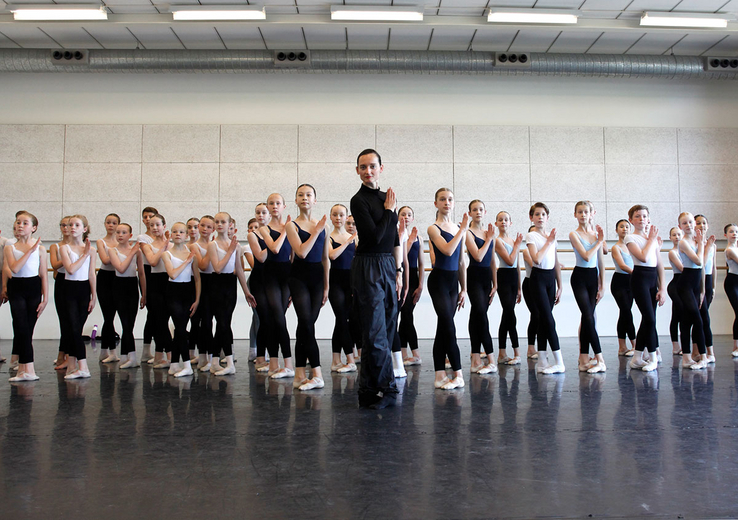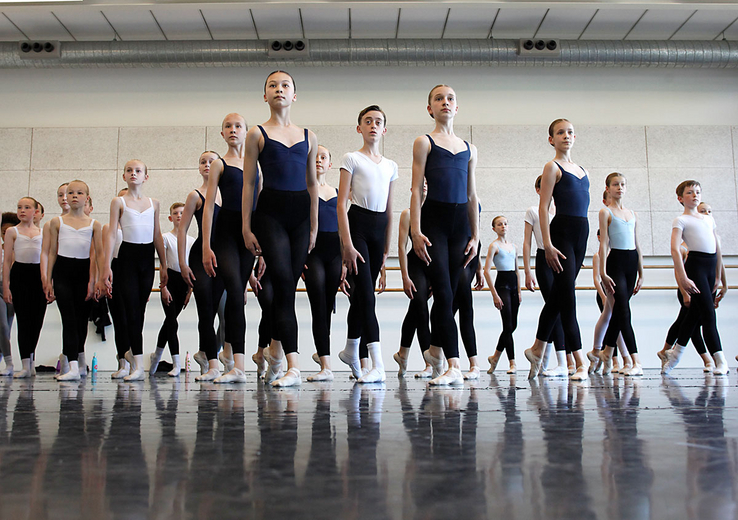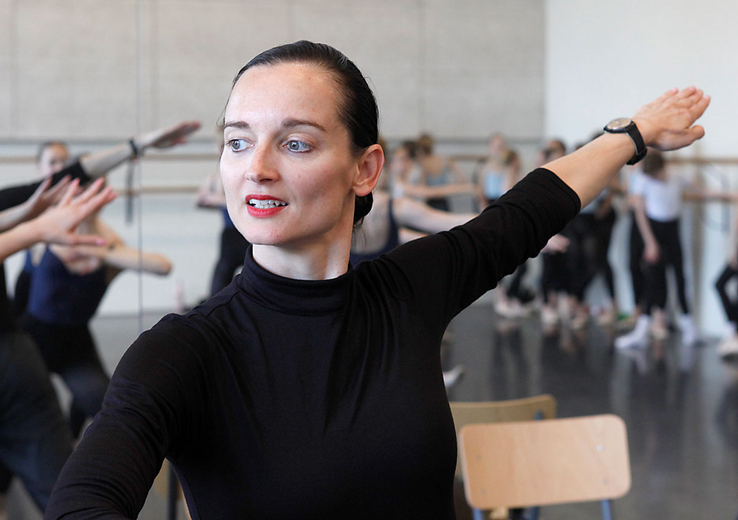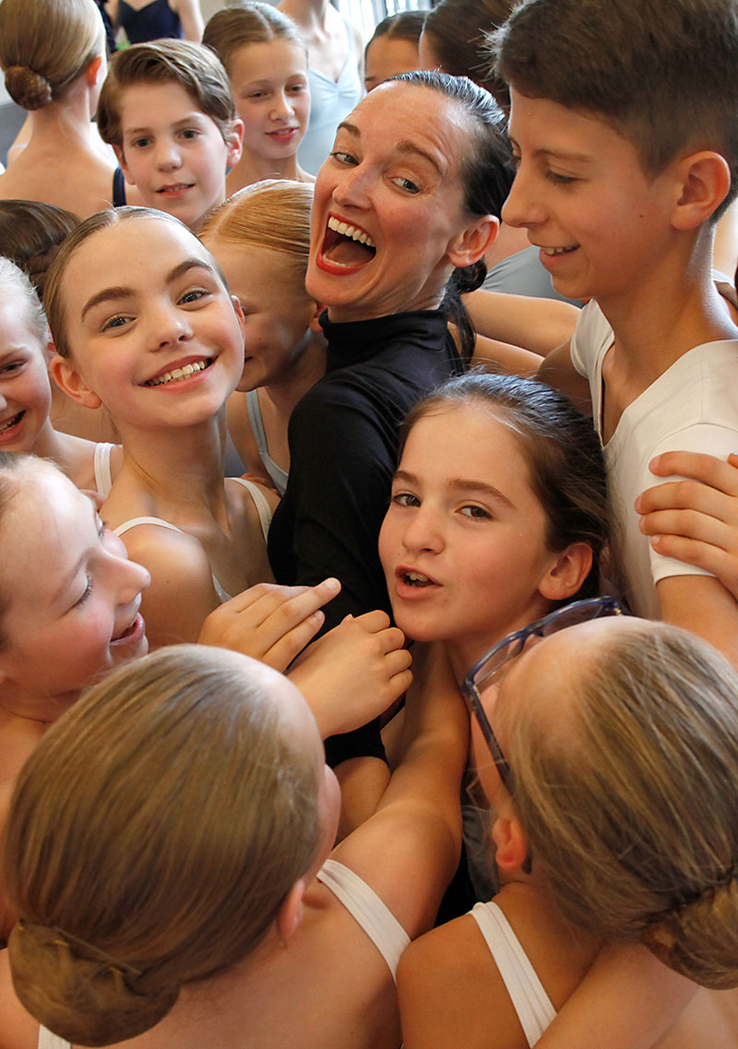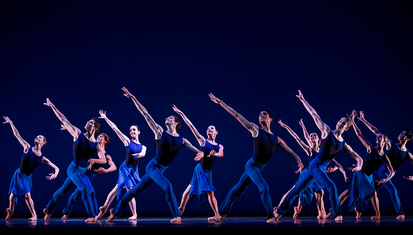At the moment, all activities in the National Ballet Academy studios revolve around rehearsing for the end-of-year performances the academy will be presenting at Dutch National Opera & Ballet, on 9 and 10 July, entitled Dancers of Tomorrow. The keyword for the programme is diversity. Besides the classical showpiece Paquita and the spectacular Bolero by Gregor Seyffert and Larisa Dobrozhan, the students will be dancing Wayne McGregor’s masterpiece Atomos and a variety of new works choreographed especially for the students. We took a look behind the scenes of the rehearsals given by Wubkje Kuindersma, who is creating a piece for the youngest pupils.
“Feel the love of dance in your heart. Because that’s why we do it. That’s the reason you’re here today”. In studio 204 of the Academy of Theatre and Dance, choreographer Wubkje Kuindersma warmly encourages her pupils just before a run-through of her new piece Together(e). It’s Saturday morning and the first time she’s got all 55 children together (from classes NBA 1, 2 and 3). It’s also the first time she’s created a work for such young dancers. “It makes me really happy to have a studio full of kids. No matter how young they are, you can already feel their passion”, says Wubkje, who was recently described as one of the most interesting newcomers on the choreographic scene by the leading American publication Dance Magazine. “It’s probably only now that I fully realise that age or standard are actually quite relative”, she says with a last vestige of surprise. “We share exactly the same passion, which makes me feel very close to the children. It’s wonderful to see all that potential and watch them discovering things. You automatically get caught up in it. It’s such a joy to experience that”.
Young love
When Ernst Meisner asked her to choreograph a piece for Dancers of Tomorrow 2019, Wubkje knew straight away which music she wanted to use: the second section of Aerial, by the Dutch composer Anthony Fiumara, with whom she had worked before. “It’s a piece of music that exudes great hope and passion, and it’s a good match for the dream of these young dancers, who are setting out on such a big journey so early in their life”.
She remembers that journey well, thinking back to the time she started her dance training. “Right from the beginning, that sense of the love of music and dance was there. That love was so natural that somehow you knew it would go on forever. And I see it now already in most of these children. You see that they’ve got that special feeling. It has nothing to do with age or background – it’s just there. They’re on a journey, and on that journey they can transform and discover qualities and talents they probably don’t even realise they have yet”.
Less is more
This love of dance – this unstoppable passion – is therefore the starting point for her creation. “If that love is so strong, then you want to share it. So that’s what I want to stimulate through Together(e): that the children feel that love and are allowed to feel it, and that they put that love into their dancing”.
Although Wubkje originally made her name mainly on the modern dance scene, in Together(e), she has remained largely true to the classical vocabulary. “I do add modern movements, but the basis is classical. And I’ve chosen for simplicity: in the lines, the walking and the arm movements – less is more. But don’t get me wrong, for the children it’s not simple at all, because every detail counts – however small. The power of ‘doing it together’ is very important for that, because if just one child loses concentration for a moment, you see it immediately”.
The title Together(e) is one of the puns that Wubkje is so fond of. “You can read it as ‘to get here’, implying that the children have already come so far that they are training at the National Ballet Academy. Or you could read it as ‘to get there’, as the journey they’re taking towards becoming a professional dancer is still a long one, or you can read it as ‘together’, because they’re doing it together. It may be an individual journey for each child, but it’s one that you go on together and share with one another”.
Honest and pure
Wubkje says she has choreographed ‘to the music’. “And to the children’s standard, which is different for each of the three year groups and so also a journey that’s reflected in my choreography. And I’m truly amazed at how quickly that development takes place. Even in the couple of weeks I’ve been here. You see some children really leap ahead. It’s also incredible to see how prepared they are to work hard and really go for it. They’re quick, creative and musical, and actually they’ve already got a very professional work attitude for their age. And besides all that talent, enthusiasm and passion, of course I’m also enjoying the fact that they’re still so honest and pure. That makes the work process very pleasant and sincere”.
It’s nearly the end of the rehearsal. When rehearsal director Fred Berlips has given the children a few corrections – “Cyan, where’s your head?”, “Owen, what on earth are you doing?”, “Kids, all of you, work with energy!” – Wubkje dances the final section alongside the children. With her petite physique, tight black clothing and hair slicked back, she looks almost like one of them, despite the age difference. As the last notes of Fiumara’s Aerial fade away, the children throw themselves on her and Wubkje is almost swamped in the affectionate group hug.
Book your tickets for Dancers of Tomorrow
Text: Astrid van Leeuwen
